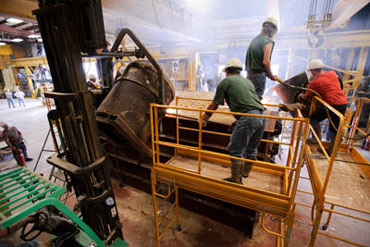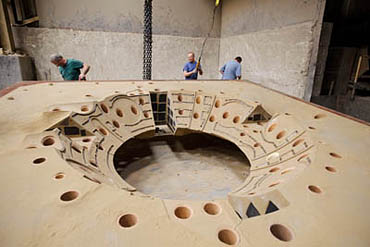Made in Wisconsin: Vessel to contain cosmic force takes shape
At the heart of most celestial objects is a dynamo. The Earth’s dynamo, spun to life in the molten metal core of our planet, generates a magnetic field that helps us find north and, perhaps more critically, shields us from solar winds that would otherwise singe our planet.
Video: Made in Wisconsin
Stars and other planets have dynamos, and so do galaxies and clusters of galaxies.
And soon, Wisconsin will have the closest thing this side of the solar system to a cosmic dynamo.
With support from the U.S. National Science Foundation (NSF) and the specialized talents of four Wisconsin companies, the finishing touches are now being put to a 3-meter diameter, hollow aluminum sphere designed to hold in a vacuum a dynamo-generating 200,000-degree Fahrenheit plasma.
The vessel now being constructed will be at the heart of a new University of Wisconsin–Madison laboratory and promises researchers their best opportunity to put cosmic dynamos under a microscope.
Until now, scientists, generations of whom have labored to tease out the secrets of cosmic dynamos, have been relegated to studying the phenomena from vast, usually astronomical distances.

After pouring more than 7,000 pounds of molten aluminum on June 16, 2011, workers at Portage Casting and Mold Inc. in Portage, Wis., open a five-section-mold that formed one of two nine-meter-diameter hemispheres needed for the main vacuum vessel of the Plasma Dynamo Facility being installed at Sterling Hallon campus.
Photo: Jeff Miller
“The project itself is to study how magnetic fields are generated in planets and stars,” explains Cary Forest, a UW–Madison professor of physics who will direct the effort formally known as the Madison Plasma Dynamo Experiment.
To do that, Forest and his colleagues required a specialized vessel to contain the types of high-temperature plasmas observed in space. Sometimes referred to as the fourth state of matter, plasmas are superheated gases where the atoms that make up the gas have been stripped of their electrons, leaving a conducting, highly electrified collection of atomic nuclei and free electrons.
After a nationwide search for a company to cast the hollow, thick-walled aluminum sphere that will contain the plasma at the core of the experiment, Forest’s team settled on Portage Casting & Mold (PCM), a company less than an hour from Madison. The company specializes in fabricating large cast and fully machined molds, patterns and core boxes for plastic companies and foundries nationally.
PCM, according to the company’s director of tooling Dan Griep, was excited to land the project, which was funded primarily through a $2.4 million grant awarded through NSF’s Major Research Instrumentation Program to build and operate the experiment.

Using $2.4 million in stimulus funding from the National Science Foundation (NSF), the experiment is a continuation of research studying the origin of magnetic fields in the universe and exploring the self-generation of magnetic fields in a plasma dynamo as a potential energy source.
Photo: Jeff Miller
“This relationship is more important than ever,” explains Griep. “There are a lot of funds flowing through the state of Wisconsin in these projects. If we can capture even half of the new UW business, it would have a huge impact on not only employment, but enhance our ability to identify new business and understand where we should focus in the future to support programs that are cutting edge across the UW System.”
The opportunity to participate in building the apparatus for the dynamo experiment, says Griep, will help the Wisconsin company compete nationally and internationally for similar projects simply through exposure.
“The foundry-tooling industry in Wisconsin is alive and well and we are definitely open for this business,” says Griep.
For the university, according to UW–Madison project engineer John Wallace, casting the plasma containment vessel and other work done in close proximity to Madison provides an opportunity for physics students to see first-hand how complex experimental equipment is fabricated, experience that will help them in future work.
The aluminum sphere will be cast in halves and, after machining, will weigh in at about 10,000 pounds. Prior to final machining, the vessel will be subjected to an X-ray analysis by Lafayette Testing Services, a Milwaukee firm, to ensure that the cast sphere is free of voids.
The halves will then be shipped to D&S Machine Service in Luxemburg, Wis., for sizing after which they will be returned to PCM for machining on large, five-axis milling machines capable of sculpting the sphere into its final form. When the machining process is finished, the sphere will be cleaned and tested for vacuum integrity at PCM’s test facility in Portage.
When complete, the inside of the chamber will be coated with alumina, a ceramic material that can hold up to the high plasma temperatures. Two Wisconsin companies, says Forest, are bidding to perform that work.
“It is an enormous advantage to actually talk to the people making the object and to work with them when we are designing the experiments,” Forest says.
When the chamber is finished, it will be moved to a newly refurbished laboratory in Sterling Hall. The device is expected to be delivered in the fall and the first plasmas will be generated early in 2012, according to Wallace.
The fact that the central, critical element of the Madison Plasma Dynamo Experiment could be built in Wisconsin is gratifying, says Forest.
“We are particularly proud of this aspect of the project,” he notes. “That, after a national search, we found we could do this in our backyard, with Wisconsin companies and local expertise, is exciting.”
Subscribe to Wisconsin Ideas
Want more stories of the Wisconsin Idea in action? Sign-up for our monthly e-newsletter highlighting how Badgers are taking their education and research beyond the boundaries of the classroom to improve lives.




